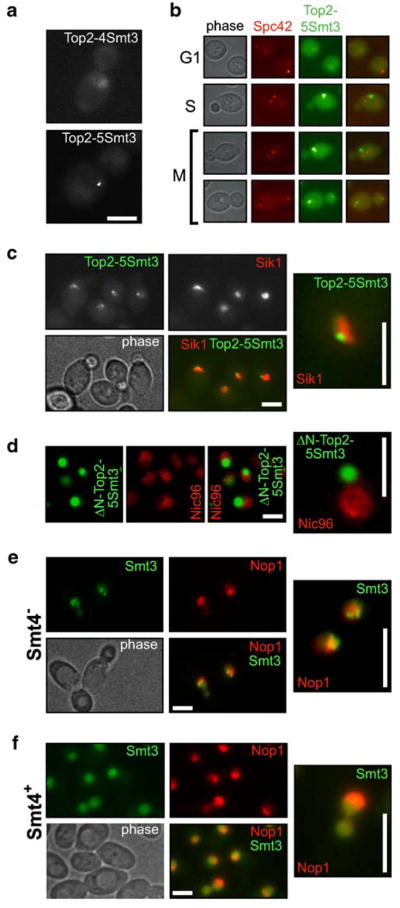Fig. 4.
Top2p polysumoylation is a signal for sub-nucleolar localization. a Diploid cells expressing Top2p–4Smt3–GFP (AS620) and Top2p–5Smt3–GFP (AS621). Cells were analyzed by microscopy as soon as transformants appeared on the plates, to avoid progressive loss of CSM SMT3 copies. The 4× construct (AS620) shows some enrichment of subnuclear structures, while the 5× construct (AS621) results in a compact dot-like staining in the nucleus. Scale bar (here and everywhere)=5 μm. b Top2p–5Smt3–GFP does not colocalize with kinetochores. Unlike Top2p–1Smt3–GFP (Takahashi et al. 2006), Top2p–5Smt3–GFP does not show colocalization with Spc42p-mRFP (Huh et al. 2003; AS622 strain). c Top2p–5Smt3–GFP localizes to nucleolar periphery. Diploid strain coexpressing Sik1p–mRFP (a nucleolar marker) and Top2p–5Smt3–GFP (AS623) was analyzed by fluorescent microscopy. For more than 100 GFP+ cells counted, a complete coincidence was observed between the GFP dot (Top2p–5Smt3–GFP) and the nucleolus. Higher magnification reveals that Top2p–5Smt3–GFP is in a subnucleolar domain close to the edge of the nucleolus (the insert). d The activity of Top2p core is required for subnucleolar localization of the Top2p–5Smt3 fusion. The COOH-tail of Top2p–5Smt3 lacking the enzymatic and DNA-binding domains of Top2p (Δ1-1218 TOP2) was expressed from GAL1 promoter with N-terminal fusion of GFP (pYT1108) in a Nic96p-mRFP strain (Nic96-EY0987; Huh et al. 2003). The Nic96p-mRFP marker was used to visualize boundaries of the nucleus. e The GFP–Smt3 protein is concentrated in the subnucleolar area in smt4Δ cells. The smt4Δ cells expressing GFP–Smt3p as a single source of SUMO (from the native SMT3 promoter) show accumulation of SUMO signal in a subnucleolar structure, Nop1p-mRFP was used as a nucleolar marker (1-YT626). f The bulk of GFP–Smt3p is not concentrated in the nucleolus in wild type cells. This control experiment for the e was done with the similarly marked Smt4+ wild-type strain (2-YT627)

